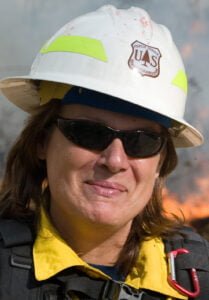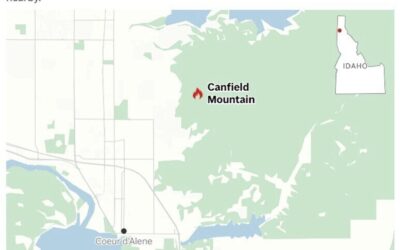I’ve written and told a lot of stories about leadership in the fire service. What good leadership looks like and how to be a good leader, I’ve talked about it a lot. Episode #90 at BobbieOnFire.com is all about an important lesson from the Dude, South Canyon and Yarnell Hill fires. It’s a worthwhile story to listen to. I’m not going to re-tell the story here, but there’s a commonality to this story and that one. It’s about communications. Based on what he saw at the Dude Fire, Paul Gleason developed LCES. Keeping in that same vein, I want to talk about communications on the fireground.
Years ago, I was dispatched to the Plumas NF in northern California. I was one Division Sup amongst many on a large fire. It was steep country, thick with manzanita brush and an overstory of ponderosa pines. The fire had been very active and all the DIVS were spread thin.
During one shift, I met with 2 of my neighboring DIVS up on a hot dusty ridge high above the Feather River canyon. Few words were spoken. I could have used their local insights on the weather and topography, but none were given. When I asked what kind of progress they were making on their divisions, I didn’t get much in return. A few grunts maybe, but that was it. It would have been helpful for them to share some of their SA with me since my resources and our success would impact on their own. From my biased perspective they just seemed like they were being too cool to be talkative and share information. Maybe it was because they didn’t know me. Maybe it was because I was female. I don’t know why, but there was very little information exchanged on ridgetop that hot afternoon.
That experience wasn’t unique. If I worked with my own team, there was more information exchanged between friends. But how often do you go to a large fire and find yourself working only with folks you know. It’s more likely you’ll see a couple of friendly faces in a crowd. But mostly you’re working with people you barely know. So how does that dynamic affect our communications on a wildfire?
Once, while I was working on my OSC2 taskbook, I was dealing with multiple DIVS. Many of them were guys I knew but a few came in from other regions. There was one particular DIVS who I didn’t know. But he seemed knowledgeable enough. He was taller than I am, wore dirty Nomex, hadn’t shaved in days, sported a big mustache and spoke in monosyllabic grunts. Doesn’t that sound like half the firefighters you’ve worked with? That’s all I knew about him. He was a carded DIVS from another Region, so I assumed (like we all have to do) that he was a competent and knowledgeable leader.
The rub began at about 1300 on his second shift on the fire. I wanted an update for some critical work that was getting done. I called on the radio:
“Division Bravo, Operations,”
Wait….
“Division Bravo, Operations.”
Finally, “Go ahead Operations.”
I responded, “Hey Joe, I need a progress report on your Division.”
His answer? “It’s all good.”
That was it. With multiple crews and resources and over 75 firefighters, all I get is… it’s all good.
It’s all good? That’s it? His branch was critical to our success that day and as the OSC2(t), all I know is… yea, it’s good. Maybe I should just go back to camp, relax and do some “sport eating” out of my 3 day sack lunch. No, that’s not how this is going to work. Not even close.
“Division Bravo, what I need to know… What I want you to report on is your progress so far. Have the crews made it up to the rock outcrop yet?”
He answers, “Ah, no, not yet. We had some difficulty getting the buggies to the drop point. So we were a little delayed.”
And there’s more, “Oh and the contract fallers didn’t have appropriate PPE so we’re trying to get some gear for them so they can get back to work. But I think we still might complete the line today.”
OK, now that all sounds reasonable. Sounds like a typical day on the line. Issues like these come up. And the DIVS was dealing with them. No problem. But I needed to know what he knew. I needed to be aware that progress wasn’t what we had planned for. We might not meet our goal for the shift. The issue wasn’t whether Joe was doing a good job on his division. The issue was me having to claw the information out of him so my SA was at the appropriate level. And isn’t that really part of his job too?
I have this idea that many firefighters want to look and act like Sam Elliott. Two lonesome ‘ol firefighters meet on the line.
Sam says, “How’s it goin?”
Then the other Sam Elliott wannabe scratches himself, spits in the dirt, kicks a few rocks and says, “Yep, it’s all good.”
I know, I know. Calm down, this is just an exaggeration. But there’s truth to this scenario. The wildland fire service has bred in us an independence and self-sufficiency that has made us successful. We succeed because we know the leaders intent and what the desired end state is. But that autonomy comes at a price. When a supervisor wants details about an operations progress, it can be seen as, “you don’t trust us!” When I would hear that as an OPS, it would drive me crazy.
Every resource on a fire is like a piece of a huge jig saw puzzle. Each engine and crew, each strike team and division, functions as a part of the whole. And it’s critical that someone knows where all those parts are and what they’re doing. Not just what assignment they were given in the morning, but what they’re actually doing now.
We depend on and applaud motivated self-starters who get after a task when they see what needs to be done. They don’t wait to be told. Our success in the wildland fire service depends on them. But can this go too far? What about a crew who has to change their tasks for the day because during the night the fire spotted over a ridge and now their assignment in the IAP is out of date? Of course, adjust the plan and get to work. But you still have to let your STL or DIVS know what’s going on. See the big picture, adjust the assignment and communicate with your supervisor and your adjoining forces. Good job!
What if resources just started leaving their division to engage on another division because fire activity was picking up there? I witnessed this very thing in southern California once. About 30 type 1 engines left their assignments to go help a strike team that needed assistance with increased fire activity at their location. But there was no coordination, no communication, no one even asked if they should leave their assignment to go help. The result was 25 too many engines responded and stopped traffic on highway 101. Not a good job. Not too professional.
If you listened to the podcast about the Dude, South Canyon and Yarnell Hill fires, you know how I feel about speaking up and communicating. My experiences and baggage from past fatalities have affected me to the point that I probably over communicate. I admit it. But it is better to over communicate than to under communicate, especially in our line of work. Cowboy communications is just my shorthand designation to seeing two dirty grizzled old firefighters standing on that ridge top, smoke boiling up from below…
“How’s it goin?”
“Yep, it’s good, it’s all good.”
Now Available
Both Sides of the Fire Line is Bobbie Scopa’s uplifting memoir of bravely facing the heat of fierce challenges, professionally and personally. It’s available now.
Order from Amazon Order from Barnes & Noble

 Bobbie Scopa started her career as a seasonal firefighter in 1974. After graduating from Arizona State University, she went on to work in fire and natural resource management. Eventually she left the wildand agencies to work full time for a structure fire department. She finished her Masters in Forestry at NC State then went back to the US Forest Service and BLM eventually becoming the Assistant Regional Fire Director in Region 6. Bobbie has spent many years working as a type 1 and 2 Operations Section Chief. You can listen to Bobbie tell audio stories from her long career at BobbieOnFire.com. She has also recently completed her memoir titled “Both Sides Of The Fire Line”. It will be available through Chicago Review Press late summer of 2022.
Bobbie Scopa started her career as a seasonal firefighter in 1974. After graduating from Arizona State University, she went on to work in fire and natural resource management. Eventually she left the wildand agencies to work full time for a structure fire department. She finished her Masters in Forestry at NC State then went back to the US Forest Service and BLM eventually becoming the Assistant Regional Fire Director in Region 6. Bobbie has spent many years working as a type 1 and 2 Operations Section Chief. You can listen to Bobbie tell audio stories from her long career at BobbieOnFire.com. She has also recently completed her memoir titled “Both Sides Of The Fire Line”. It will be available through Chicago Review Press late summer of 2022.


